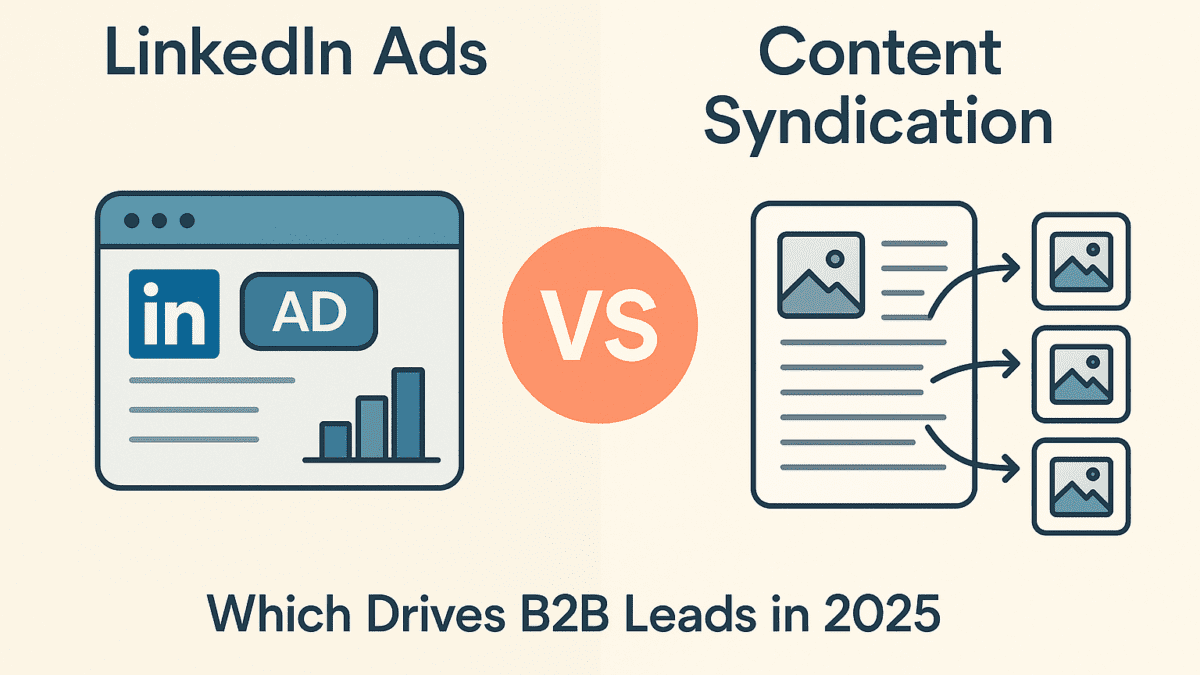LinkedIn Ads vs. Content Syndication: What Drives Better B2B Leads in 2025?
Table of Contents
Introduction
In 2025, B2B marketers are no longer simply asking “Where is my audience?”—they’re asking “Where does my audience convert?” Two of the most powerful and performance-driven channels—LinkedIn Ads and Content Syndication—are often positioned as rivals in the fight for high-quality leads. But which one truly drives better ROI, deeper engagement, and scalable growth in today’s crowded digital ecosystem?
In this blog, we’ll break down both strategies, compare their strengths, and help you decide which is the smarter investment for your B2B marketing stack in 2025.
What Are LinkedIn Ads?
LinkedIn Ads are paid advertisements served to users on LinkedIn, the world’s largest professional network. Ad types include Sponsored Content, Message Ads, Conversation Ads, and Dynamic Ads—all designed to engage professionals based on industry, job title, seniority, and firmographics.
Why Marketers Love LinkedIn Ads:
- Hyper-targeted audience segmentation
- Built-in lead gen forms
- ABM-friendly with Matched Audiences
- Perfect for top- and mid-funnel awareness
However, LinkedIn CPCs are rising, and lead quality can vary without nurturing workflows.
What Is Content Syndication?
Content Syndication is a lead generation strategy where gated assets like whitepapers, eBooks, or case studies are distributed through third-party networks to reach new audiences. These platforms capture opt-in data from interested professionals and deliver them as verified leads to marketers.
Why It Works for B2B:
- Guaranteed lead volume and quality filters
- Access to niche audiences across verticals
- Ideal for lower-funnel content and intent-driven campaigns
- Great for building a nurture pipeline
In 2025, platforms like WhitepapersOnline and TechTarget are making content syndication smarter with intent signals, AI scoring, and topic-based personalization.
You May Also Like: Deconstructing the SaaS Buyer Journey: Content Syndication Touchpoints That Drive Conversion from Awareness to Advocacy
Performance Showdown: LinkedIn Ads vs. Content Syndication
| Criteria | LinkedIn Ads | Content Syndication |
|---|---|---|
| Lead Quality | Medium to High (if targeted) | High (filtered by criteria like job title, industry) |
| Lead Volume | Variable (depends on budget) | Guaranteed |
| CPL (Cost per Lead) | $150–$350 | $45–$150 |
| Intent Signals | Weak to Moderate | Strong (based on content engagement) |
| Funnel Stage | TOFU & MOFU | MOFU & BOFU |
| Nurturing Needs | High | Moderate |
| Scalability | Good, but expensive | Highly scalable across regions and industries |
2025 Trends That Impact Both Channels
- AI-Powered Targeting: LinkedIn’s AI tools now recommend creative and budget optimizations, but content syndication providers are using AI to route leads based on buyer stage and topic interest, improving downstream conversion.
- Privacy & Compliance: With stricter global privacy laws (e.g., GDPR 2.0 updates), first-party lead capture in content syndication is more transparent, while ad platforms face pressure over tracking cookies and data use.
- Buyers Want Value Early: According to a 2025 Gartner report, 67% of B2B buyers prefer to consume 3–5 content pieces before speaking to sales. Syndicated content meets that need directly, while LinkedIn ads often push straight to forms or demos.
When to Use LinkedIn Ads
- Brand Building & Thought Leadership
Promote leadership content, podcasts, or trend reports to elevate brand perception. - ABM Campaigns
Use Matched Audiences for targeting decision-makers in target accounts. - Retargeting
Great for re-engaging users who visited your site or downloaded top-funnel assets.
When to Use Content Syndication
- Lead Pipeline Acceleration
Need 500 leads this quarter? Syndication ensures volume with intent qualification. - Nurture-Ready Leads
Leads arrive having consumed a resource—perfect for email drips, webinars, and demos. - Vertical/Region Expansion
Syndication partners can reach niche industries or new geos without building custom audiences.
Real-World Example
A SaaS company selling cybersecurity tools for SMEs ran a split test:
- LinkedIn Ads: $10,000 spend, 60 leads, CPL = $166
- Content Syndication: $10,000 spend, 180 leads, CPL = $55
The LinkedIn campaign produced more brand engagement, but the content syndication campaign delivered 3x more sales-qualified leads (SQLs)—ultimately yielding a 2.4x better ROI.
Final Verdict: It’s Not Either/Or—It’s AND
LinkedIn Ads and Content Syndication serve different roles in the buyer journey.
While LinkedIn excels at building awareness and warming up cold audiences, content syndication brings in qualified, intent-rich leads that can be nurtured or directly passed to sales.
The Winning Formula in 2025:
LinkedIn Ads (TOFU) + Content Syndication (MOFU/BOFU) = Full-Funnel Growth Engine
Want high-quality B2B leads that convert?
At iTMunch, we help SaaS and tech marketers amplify their reach through smart content syndication, intent-based targeting, and lead nurturing workflows tailored to your ICP.👉 Contact us now to see how we can scale your B2B demand generation in 2025.





